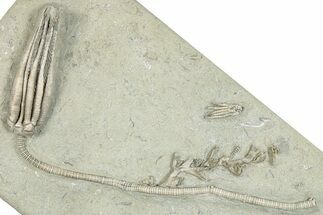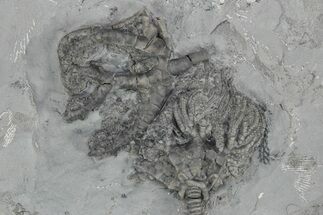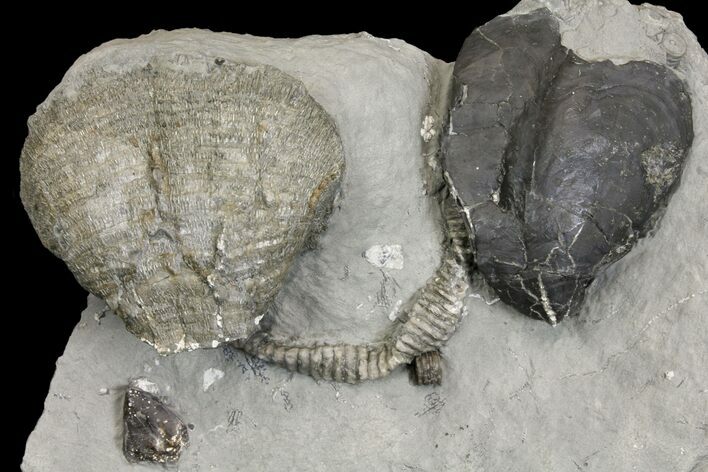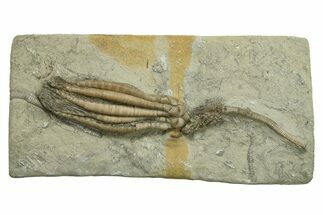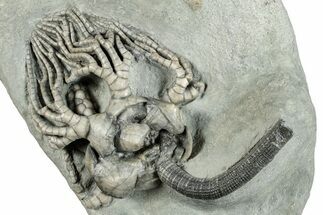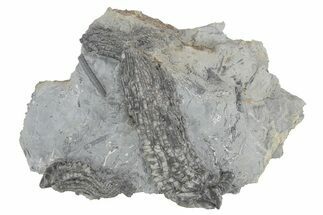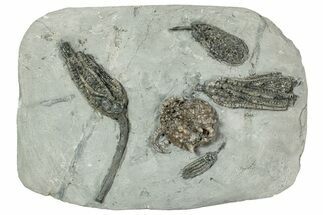This Specimen has been sold.
6.3" Fossil Brachiopod and Gastropod Association Plate - Indiana
This is a 6.3" wide plate that contains a natural association of a brachiopod (Echinoconchus alternatus) and two gastropods of the genus Platyceras, collected from the Edwardsville Formation of Crawfordsville, Indiana. In addition to these fossils, there is a crinoid stem that runs across the rock. The fossils have been exposed from the rock by air abrasives. Comes with an acrylic stand.
Brachiopods are members of the phylum Brachiopoda. They are clam-like with wide shells composed of two halves called valves. They are filter feeders that live fixed to rocks or on the seafloor. Brachiopods first appeared in the early Cambrian as simple forms with non-articulating shells. Their diversity peaked during the Devonian, and there are currently 12,000 described fossil species of Brachiopoda from 5,000 genera. Most species of brachiopod died out during the Permian-Triassic Extinction but about 450 species still live today. They live in cold marine environments like polar seas or continental shelves and slopes. The largest fossil Brachiopod found is 7.9 inches (200 mm), but most are 2-4 inches (3-8 cm). Living Brachiopods also fall into this range.
Brachiopods are more closely related to Bryozoans than Mollusks. The easiest differences to identify are in the shells of clams, part of the mollusk family, and Brachiopods. Mollusk shells are divided into left and right while brachiopod shells are divided top (dorsal) and bottom (ventral). Mollusk shells are usually equal on the right and left. In brachiopods, the bottom shell is larger than the top. The other big difference is in how they feed: both are filter feeders, but mollusks extend their filter into the water and pull food into their shells. Brachiopods have internal feeding structures: water is drawn into the shell where the food is filtered out before expelling it out.
Brachiopods are more closely related to Bryozoans than Mollusks. The easiest differences to identify are in the shells of clams, part of the mollusk family, and Brachiopods. Mollusk shells are divided into left and right while brachiopod shells are divided top (dorsal) and bottom (ventral). Mollusk shells are usually equal on the right and left. In brachiopods, the bottom shell is larger than the top. The other big difference is in how they feed: both are filter feeders, but mollusks extend their filter into the water and pull food into their shells. Brachiopods have internal feeding structures: water is drawn into the shell where the food is filtered out before expelling it out.
Gastropods, or snails, have been around since the Late Cambrian period. The class Gastropoda contains a vast total of named species, second only to the insects in overall number. There are 611 known families of gastropods, of which 202 families are extinct and appear only in the fossil record.
SPECIES
Echinoconchus alternatus (Brachiopod) & Platyceras sp. (Gastropods)
LOCATION
Crawfordsville, Indiana
FORMATION
Edwardsville Formation
SIZE
2.6" wide brachiopod on 6.3 x 5.4" rock
CATEGORY
ITEM
#137177
We guarantee the authenticity of all of our
specimens. Read more about our
Authenticity Guarantee.
specimens. Read more about our
Authenticity Guarantee.
 Reviews
Reviews


